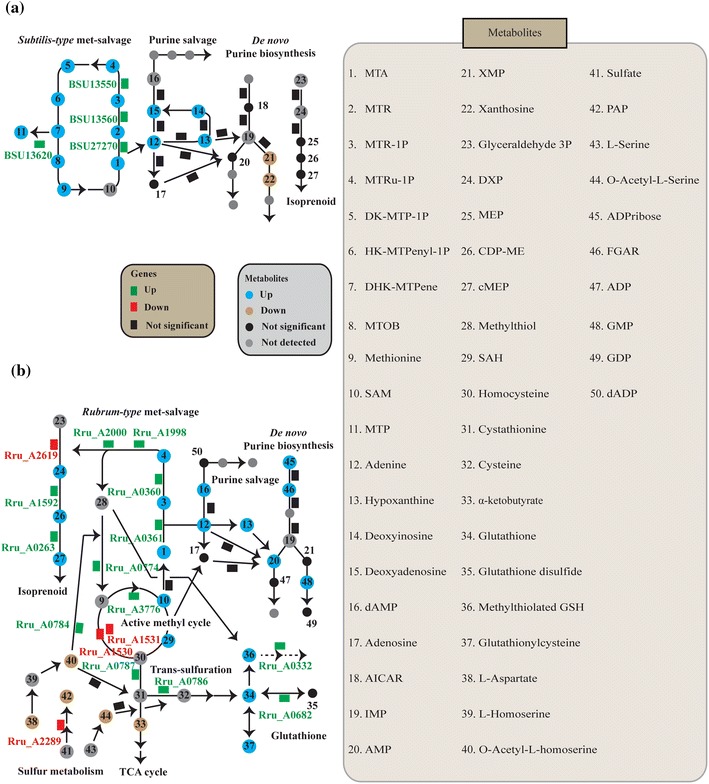Fig. 6.

A coordinated response of metabolic pathways upon MTA perturbation. Actively changing metabolic pathways upon MTA perturbation in a B. subtilis and b R. rubrum. Genes are represented by the prefixes, BSU (B. subtilis) and Rru (R. rubrum). Rectangles genes; Circles metabolites. The numbers in the circles correspond to the following metabolites: 1 MTA, 2 5-Methylthio-d-ribose, 3 S-Methyl-5-thio-d-ribose 1-phosphate, 4 S-Methyl-5-thio-d-ribulose 1-phosphate, 5 2,3-Diketo-5-methyl-thiopentyl-1-phosphate, 6 2-Hydroxy-3-keto-5-methylthiopentenyl-1-phosphate, 7 1,2-Dihydroxy-3-keto-5-methylthiopentene, 8 4-Methylthio-2-oxobutanoate, 9 Methionine, 10 SAM, 11 3-Methylthiopropionate, 12 Adenine, 13 Hypoxanthine, 14 Deoxyinosine, 15 Deoxyadenosine, 16 Deoxyadenosine monophosphate, 17 Adenosine, 18 5-Amino-1-(5-phospho-d-ribosyl) imidazole-4-carboxamide, 19 Inosine monophosphate, 20 Adenosine 5′-monophosphate, 21 Xanthosine 5′-phosphate, 22 Xanthosine, 23 Glyceraldehyde 3-phosphate, 24 DXP, 25 2-C-Methyl-d-erythritol 4-phosphate, 26 2-Phospho-4-(cytidine 5-diphopho)-2-C-methyl-d-erythritol, 27 2-C-Methyl-d-erythritol 2,4-cyclodiphosphate, 28 Methanethiol, 29 S-Adenosyl-l-homocysteine, 30 Homocysteine, 31 Cystathionine, 32 Cysteine, 33 α-Ketobutyrate, 34 Glutathione, 35 Glutathione disulfide, 36 Methylthiolated glutathione, 37 Glutathionylcysteine, 38 l-Aspartate, 39 l-Homoserine, 40 O-Acetyl-l-homoserine, 41 Sulfate, 42 Phosphoadenosine phosphate, 43 l-Serine, 44 O-Acetyl-l-serine, 45 Adenosine diphosphate ribose, 46 5′-Phosphoribosyl-N-formylglycinamide, 47 Adenosine 5′-diphosphate, 48 Guanosine monophosphate, 49 Guanosine diphosphate, 50 2′-Deoxyadenosine 5′-diphosphate). Three colors are used to represent the genes. Green up-regulation; Red down-regulation and Black genes showing no big changes in their expression levels. Four colors are used to represent the metabolites. Blue up-regulation; Brown down-regulation; Black no change; Gray metabolites that were not detected using LC–FTMS. As compared to B. subtilis, R. rubrum has an elaborate metabolic strategy to cope with a stressful environment (e.g., utilization of MTA as the sole sulfur source) through the coordinated regulation of metabolic pathways. See text for detailed discussion
